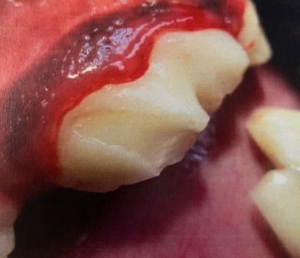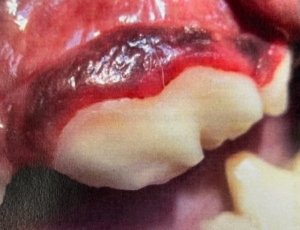Commitment to Care: Saving That Fractured Tooth


Bailey, a 10-year-old Labrador Retriever, was scheduled for a routine oral health procedure. Prior to any cleaning, an oral examination was performed and once Dr Wallen verified that all was okay with the preoperative bloodwork Bailey was then put under general anesthesia. No issues were noted at home and initially the only finding was mild tartar. Full mouth radiographs were completed and there was no bone loss, periodontal pockets, broken teeth, or other issues under the gum line. With an ultrasonic scaler I proceeded to remove the built-up tartar from the teeth.
After removing the tartar from the large upper premolar, I noticed an uncomplicated crown fracture on the tooth, most commonly called a slab fracture. After careful examination of the tooth and confirmation from the doctor that the pulp cavity was not exposed, we were able to save the large tooth. A bonded sealant was applied to protect it from breaking any further and to seal the dentin tubules, protecting them from bacteria. Sealing the tubules can prevent an infection that will result in a root canal or surgical extraction. This bonded sealant will help preserve the tooth for the immediate future, but there may be a chance it will get compromised at a later date and will then need to be extracted.
This is where we talk about fractured teeth: Fractured teeth are common in all dogs, especially larger breeds. They tend to be more aggressive when chewing on harder items which have the potential to break their teeth. The surface of the tooth is known as the ‘crown’, there are two types of crown fractures, complicated and uncomplicated. A complicated fracture is when the nerve of the tooth is directly exposed and can be extremely painful. If your pet has a complicated crown fracture, the only course of treatment is extraction of the tooth or a root canal which will need to be performed by a specialty pet dentist. An uncomplicated crown fracture is when the tooth is broken but the nerve is not directly exposed. When an uncomplicated crown fracture is present, bonded sealants are best to help save the tooth for as long possible.
Bonded sealants will reduce sensitivity (pain), block off the pathway for infection, and smooth the tooth to decrease periodontal disease. Bonded sealants are a relatively easy and inexpensive way to treat an uncomplicated fracture. To apply the bonded sealants, the tooth will need to be prepped by smoothing it with a fine stone bur and followed up with four different grades of polishing disks ranging from coarse to ultra-fine. The next step is to apply an acid etch gel for 30 seconds, wipe that off, then follow with a rinse for 30 seconds with an air/water mixture and then dried with just air. Once completed a thin layer of bonding agent is applied to the fracture site and dried with a gentle air flow. An LED curing light is then used to cure the area for 30 seconds. During this step always make sure to wear protective glasses and follow safety instructions.
Next, put a layer of unfilled resin on the prepped area and light cure as before. Check for smoothness, and add another layer of resin if needed, using the curing light between the layers. All teeth that have been treated with bonded sealant should be radiographed again in 6 to 12 months to ensure the tooth is still vital.
Bonded sealants tend to last at least a year unless the tooth refractures. Moving forward it is important to monitor the toys & treats that your pet chews on. Some of the worst things for your dog to chew on are antlers, cow hoofs, and other hard objects. Your pet uses their mouth like we use our hands, they are constantly picking things up which is another reason why having an annual oral health procedure is an important part of your pet’s overall health.
